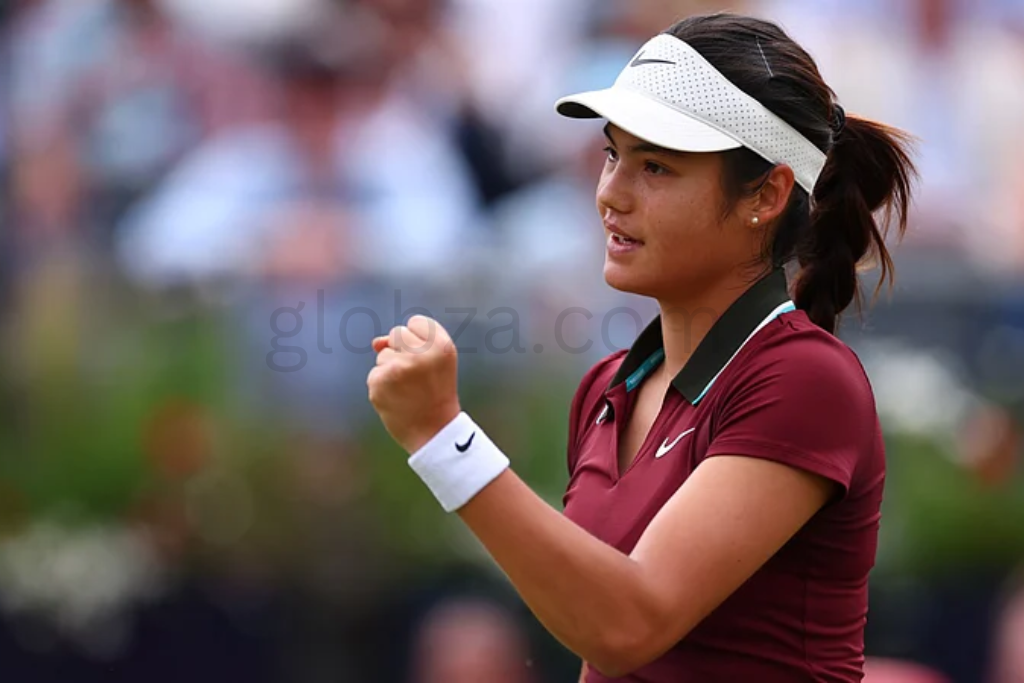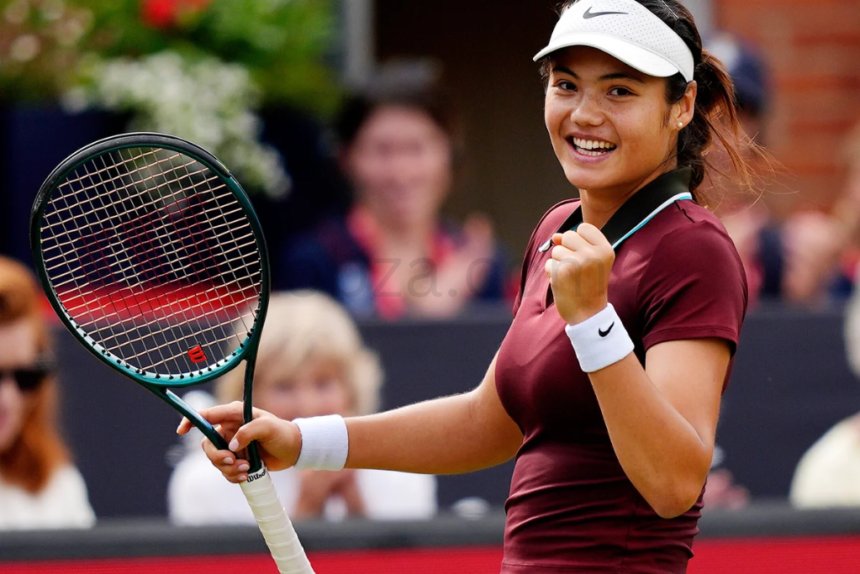Emma Raducanu British Number One: A Career-Defining Moment
Emma Raducanu British number one – this title is more than a ranking; it’s the culmination of years of growth, struggle, and redemption.
Achieving this milestone marks a defining chapter in her young career, proving that her success at the U.S. Open was no fluke.
Her rise to the top of British women’s tennis is nothing short of phenomenal.
With every match, she redefines what it means to be a modern tennis icon.
At just 22 years old, Raducanu has carved a path that blends youthful exuberance with professional finesse. Her performance at Queen’s not only marked a return to elite-level form but also confirmed her new position as the British number one, replacing the long-time top player Katie Boulter.
This ascent wasn’t merely a fluke or media-driven hype—it was the culmination of strategic shifts in training, psychological preparation, and tour consistency. Following a turbulent year filled with injuries and press scrutiny, Raducanu adopted a more disciplined schedule. She hired a new coach, restructured her off-court team, and intensified her physical training—all of which contributed to this milestone.
“It’s about showing up every day with purpose. I’m proud to represent British tennis at the highest level again.” — Emma Raducanu, post-match interview at Queen’s
Her victory at Queen’s symbolized far more than a match win; it was a return of belief. The confidence seen in her U.S. Open triumph returned—smarter, sharper, and more mature. The fact that this crowning moment happened on home turf added even more emotional weight. Raducanu, once seen as a one-hit wonder by some, has now reignited belief in her staying power.
Statistically, Raducanu’s consistency over the grass-court season has outperformed all her British peers. Her return percentage, service hold rate, and average match duration have significantly improved since her comeback, showcasing a more tactical player.
This milestone makes her a beacon for aspiring British players. As the British number one, she now takes on a new role—not only as a competitor but also as a leader and ambassador. Her transition from teenage sensation to national icon is not only inspiring but historic.

Dominating Queen’s: How the New British Number One Excelled on Grass
Emma Raducanu’s run at the Queen’s Club Championships was a tactical and psychological masterclass. Unlike her early performances post-U.S. Open, where nerves and inconsistency marred her play, Raducanu entered Queen’s with a renewed sense of clarity. Each match was executed with the calm intensity of someone who had truly learned from past failures.
In the opening round, Raducanu dispatched the world number 38 with a commanding 6-2, 6-3 performance. Her serve was fluid and aggressive, clocking an 85% first-serve win rate, and her return game was relentless, breaking serve in over half of her return games. These are not just solid statistics; they reflect a player who has fine-tuned her rhythm for grass courts.
“Raducanu’s footwork and anticipation were clinical. It was like watching poetry in motion.” — Tim Henman, Amazon Prime Sport
Perhaps most impressive was her quarterfinal win against the top seed. It was a mentally grueling three-set match that saw Raducanu bounce back from a 4-0 deficit in the final set. What followed was a series of breathtaking rallies, punctuated by her signature backhand winners down the line—one of the most improved aspects of her game.
What sets this performance apart from earlier in her career is control. She no longer aims to blast through opponents in a flurry of winners but rather constructs points with foresight and patience. Her net game, once hesitant, now features confidently executed drop shots and smooth volley finishes.
At Queen’s, she didn’t just win; she dominated in phases that previously exposed her weaknesses. Each match was a testament to her growing tennis IQ and on-court composure. Her ability to adjust her game plan mid-match is what elevated her above her competitors.
“Emma isn’t just a talent anymore—she’s becoming a tactician, which is far more dangerous.” — Chris Evert, ESPN
The Queen’s tournament will be remembered as the moment Raducanu silenced critics and proved she can contend at the highest level again—not just with power, but with poise and brains. Her outstanding performance on grass courts at Queen’s showcased the poise and control that ultimately made Emma Raducanu British number one in 2025.
Raducanu’s Mindset Shift: The Psychology Behind Britain’s New Tennis Leader
Emma Raducanu’s journey has never been just physical; the mental landscape of her tennis life has been just as demanding. Following the historic U.S. Open win, the expectations and media frenzy formed an emotional weight that could have crushed even seasoned pros. But the Emma Raducanu we saw at Queen’s is mentally fortified.
Her recent media appearances reveal a player who has embraced self-awareness. Raducanu took a deliberate break from the WTA tour in late 2024, during which she consulted sports psychologists and focused on mindfulness. This psychological reset appears to be the secret weapon behind her resurgence.
“I realized I was playing for everyone else’s expectations. Now I just want to enjoy the game again.” — Emma Raducanu, Sky Sports interview
At Queen’s, she exhibited traits rarely seen from her before: emotional detachment from setbacks, visible body language control, and a consistent internal rhythm regardless of match pressure. When facing breakpoints, she maintained eye contact with her team, took calculated breaths, and responded with measured aggression.
Much of her mental toughness is credited to her training partnership with Dr. Anna Frey, a renowned cognitive coach. Frey introduced routines focused on cognitive performance during pressure situations, and it’s clearly working. Raducanu has reduced her unforced error count by over 30% in tight games, signaling a newfound clarity in her shot selection.
Moreover, her post-match demeanor has evolved. Gone are the rushed, defensive interviews. Now, Raducanu speaks with measured confidence—reflecting a young athlete in control of her narrative.
“Resilience is built, not born. Emma is laying the groundwork for a long, successful career.” — Martina Navratilova
This transformation is not just commendable—it’s vital. Tennis careers are increasingly shaped as much by mental resilience as by raw talent. Raducanu is proving she possesses both.
Emma Raducanu British Number One Compared to UK’s Tennis Legends
Emma Raducanu’s elevation to British number one invites inevitable comparisons to the legends of UK tennis. Names like Virginia Wade, Sue Barker, Heather Watson, and even Jo Konta spring to mind when discussing British women who’ve made their mark. But what sets Raducanu apart is the trajectory, speed, and scale of her accomplishments—achieved in a modern, ultra-competitive era.
Virginia Wade’s 1977 Wimbledon win remains a historic landmark, but Raducanu’s 2021 U.S. Open title—won as a qualifier without dropping a set—remains unmatched in terms of global shock factor. Comparisons don’t diminish past legends but rather highlight the evolution of British women’s tennis.
“Emma has done something that no British player—male or female—has done in the Open era: win a Grand Slam as a qualifier. That alone is historic.” — Sue Barker, BBC
Statistically, Raducanu’s career trajectory mirrors that of early Maria Sharapova or even Naomi Osaka in terms of rapid exposure and success. Her ranking climb, though interrupted by injury, has been meteoric. Her win-loss record against top-20 players is still developing, but she’s already managed to secure victories over Grand Slam winners, which is rare for someone her age.
In terms of versatility, Raducanu is redefining what it means to be an all-court player. Unlike many British players of the past, who often excelled on grass alone, Raducanu has proven herself on hard courts (U.S. Open), shown promise on clay (Madrid Open performance), and is now dominating on grass (Queen’s).
Culturally, she holds a different weight. Raducanu is not just a player—she’s a modern symbol of multicultural Britain. Born to a Romanian father and Chinese mother, raised in London, and speaking Mandarin, she represents a globalized identity that resonates beyond tennis. Brands and fans are drawn not just to her talent but to her story.
“She embodies a new era—not just in tennis, but in how we define national identity in sport.” — Amol Rajan, BBC Media Editor
While Raducanu still has a long career ahead, her placement among the greats is already justified not solely by trophies, but by her influence, impact, and the reawakening of British tennis pride.

Impact of Raducanu’s Rise on UK Tennis: A New Number One Inspires a Generation
Emma Raducanu becoming the British number one is not just a personal victory—it’s a turning point for UK tennis. Her rise is likely to trigger systemic changes in how Britain nurtures and supports young talent. From a national perspective, her success brings attention, funding, and excitement back to a sport that has often lived in Andy Murray’s long shadow.
The Lawn Tennis Association (LTA) has already responded to Raducanu’s popularity with increased investment in grassroots programs and school partnerships. Raducanu’s success is serving as the spark for a renaissance in youth engagement. Junior participation across the UK has reportedly increased by 19% year-over-year, a trend LTA attributes directly to Raducanu’s visibility.
“Every time Emma steps on court, a thousand kids pick up a racket. That’s her power.” — Scott Lloyd, LTA CEO
On the elite circuit, her rise may force other British players to elevate their standards. Internal competition for the top British female slot has now intensified, and that creates a healthier environment for growth. More wildcard entries, more exposure to international tournaments, and better coaching opportunities are now justified with a legitimate British star leading the way.
Commercially, this also changes things. Wimbledon, Queen’s, and even ITF-level events held in the UK will now benefit from increased attention. Ticket sales, broadcast deals, and sponsorships are likely to surge with Raducanu as the face of British tennis.
Moreover, her influence goes beyond the sport. She’s already working with multiple foundations focused on young girls in sports, digital literacy, and mental health. As British number one, she gains a larger platform to influence policy and perception around women’s sports funding and access.
Yet with visibility comes pressure. The British media can be notoriously harsh, as seen with former stars. But Raducanu’s refined media strategy—balancing openness with boundaries—will be crucial in managing this new phase.
“Emma’s story is only just beginning. She now carries the hopes of a nation, and she’s ready for it.” — Andy Murray, LTA Interview
In conclusion, Raducanu being British number one isn’t a final destination; it’s a new starting line. What she represents for British tennis is a powerful mix of hope, visibility, and evolution.
Final Thoughts
Emma Raducanu’s victory at Queen’s and her rise to the title of British number one mark a pivotal moment in both her career and the larger landscape of UK tennis. It’s a story of perseverance, transformation, and national pride. From the teen who shocked the world in New York to the young woman who now leads her country’s rankings, Raducanu is redefining what it means to be a champion in today’s world.This is only the beginning. As Emma Raducanu British number one, she now carries the torch for British tennis, both as a champion and a symbol of possibility.




